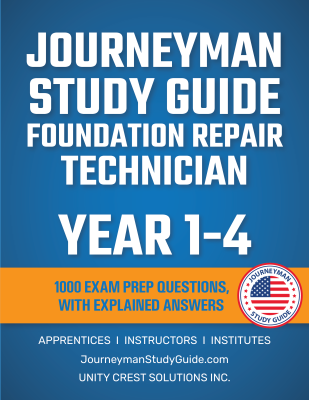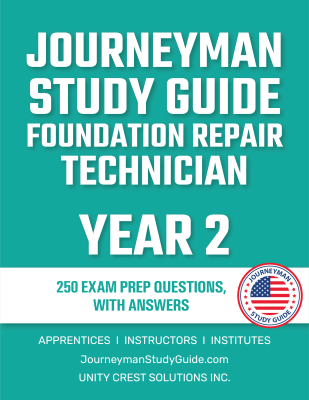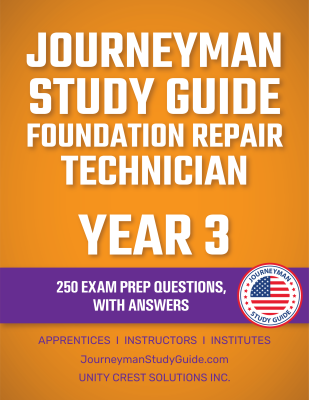Questions, Answers, & Explanations
Get clear explanations behind every answer, perfect for deeper learning and more thorough exam preparation.
Site Updates in Progress: Things might look different as we work on enhancing your experience.
What is a Foundation Repair Technician?
Foundation Repair Technicians are specialized tradespeople who assess, diagnose, and repair structural foundation issues in residential and commercial buildings. Using advanced tools and techniques such as hydraulic jacks, steel piers, and waterproofing systems, these professionals stabilize structures and restore integrity to compromised foundations. Their work is critical to maintaining property safety and value, especially in areas prone to soil shifting, flooding, or seismic activity.
Key Responsibilities
Foundation Repair Technicians perform a variety of technical and physical tasks on job sites:
Skills and Traits for Success
A strong Foundation Repair Technician combines technical know-how with physical resilience and problem-solving skills:
Industries Where Technicians Thrive
Foundation repair specialists are in high demand across sectors:
Why Choose This Career?
A career as a Foundation Repair Technician offers stability, competitive wages, and upward mobility:
Ready to Build a Career in Foundation Repair?
Our study guides, Q&A products, and interactive online tests help you master the skills and pass certification exams with confidence. Prepare for your future in structural repair.
What to Expect on the Foundation Repair Technician Certification Exam
The Foundation Repair Technician Certification Exam verifies a technician’s ability to assess, stabilize, and waterproof structural foundations to U.S. construction standards. Employers such as Olshan Foundation Repair, Ram Jack, and American Structural Solutions, as well as unions like the Laborers’ International Union of North America (LIUNA), prefer certified candidates who demonstrate practical knowledge and regulatory compliance.
Certification proves that you can safely operate heavy lifting systems, understand soil behavior, and follow OSHA and local code requirements—making you a reliable hire for residential, commercial, and public infrastructure projects.
Exam Format
Most exams are structured to evaluate both theory and hands-on experience:
Key Topics Covered
The exam breaks down into several essential knowledge areas:
Passing Requirements
A score of 70% or higher is typically required to pass the written portion. Practical assessments may include hands-on demonstrations of lifting a test slab, installing an anchor system, or conducting a waterproofing inspection.
Tips for Exam Success
Prepare with Confidence
Master your exam with our study guides, detailed Q&A explanations, and real-world practice tests tailored for Foundation Repair Technicians.
What Types of Questions Are on the Certification Exam?
The Foundation Repair Technician exam is designed to assess your practical knowledge of structural stabilization, soil analysis, and waterproofing systems. You’ll face questions that simulate real job conditions—from pier installation to drainage troubleshooting—and will need to apply math, safety protocols, and technical reasoning.
Understanding the types of questions in advance helps you study efficiently and perform confidently on exam day.
Common Question Formats
Here’s what to expect:
Sample Questions
1. Safety Practices
Question: What is the minimum required trench depth before shoring or shielding is necessary under OSHA standards?
2. Repair Techniques
Question: Which method is most effective for lifting a sinking slab foundation?
3. Construction Math
Question: If each pier supports 7,000 lbs and the foundation load is 56,000 lbs, how many piers are needed?
4. Equipment Identification
Question: Which tool is used to determine a foundation’s tilt over time?
How to Succeed on the Exam
Boost Your Confidence with Practice
Our Q&A with Explanations help you learn why an answer is right. Our Online Tests mimic real testing conditions with scoring and timing tools that track your progress.
What Is It Like to Work as a Foundation Repair Technician?
A day in the life of a Foundation Repair Technician is hands-on, physically active, and highly technical. These professionals address some of the most critical structural issues affecting homes and commercial buildings. Whether it’s stabilizing a settling foundation in Dallas, installing drainage systems in Baton Rouge, or reinforcing crawl spaces in Atlanta, the job demands focus, skill, and teamwork.
Morning: Setup and Planning
Work typically begins around 7:00 AM with team briefings and site prep:
Midday: Repair Execution and Troubleshooting
This is when the heavy lifting happens—literally:
Afternoon: Finishing Touches and Site Wrap-Up
By late afternoon, teams focus on cleanup and documentation:
Challenges and Rewards
Challenges:
Rewards:
Want to Get Started in Foundation Repair?
Master the skills you’ll need with our expert-designed study guides, detailed Q&A products, and interactive online tests that simulate real-world exams and scenarios.
What Are the Long-Term Benefits of a Career in Foundation Repair?
A career as a Foundation Repair Technician offers growth, stability, and strong earning potential. Whether working for national companies like Ram Jack or U.S. Waterproofing, or joining a union crew with the Laborers’ International Union of North America (LIUNA), technicians can move from hands-on roles to leadership and business ownership.
Career Progression
Here’s a typical career trajectory:
Where the Jobs Are
Industry Support
Why Pursue Certification?
Ready to Grow Your Career?
Our study materials, Q&A resources, and interactive online tests help you pass certification exams and advance confidently in the foundation repair industry.
How Much Can You Earn as a Foundation Repair Technician?
Foundation Repair Technicians in the U.S. enjoy competitive wages with opportunities for advancement and specialization. From entry-level field roles to supervisory and ownership positions, earnings reflect your experience, certifications, and region. Union affiliation and industry-recognized training can significantly increase your earning potential.
National Wage Ranges
Regional Pay Highlights
Factors That Boost Your Income
Want to Maximize Your Earnings?
Use our study guides, Q&A tools, and interactive online tests to boost your qualifications and increase your value in the job market.
What Tools and Resources Do Foundation Repair Technicians Use?
Foundation Repair Technicians rely on specialized tools and resources to perform accurate diagnostics and implement long-lasting structural solutions. From pier installation to waterproofing, the right equipment and training make all the difference in delivering safe, code-compliant repairs.
Essential Tools of the Trade
Recommended Learning Resources
Why the Right Tools and Resources Matter
The right tools enhance precision and safety, while continued learning ensures technicians stay up-to-date with evolving codes, materials, and repair techniques. Whether you’re working in a crawl space or on a slab foundation, preparation is key.
Ready to Get Equipped?
Study smarter and work safer with our comprehensive learning resources. Our Q&A products, Online Tests, and explanations are built to help you pass exams and perform on the job.
Where Can You Learn Foundation Repair in the U.S.?
Foundation repair is a specialized trade that combines elements of structural engineering, excavation, waterproofing, and construction safety. Across the United States, technical colleges, union training centers, and manufacturer-based programs offer hands-on education that prepares aspiring technicians for real-world job demands and certification exams.
Types of Education Programs
What You’ll Learn
Choosing the Right Program
Get Trained for Success
Pair your education with our expert study guides, Q&A tools, and online tests to fully prepare for the field and certification exams.
Why Join a Union or Connect with Top Employers?
Unions and industry-leading employers offer the strongest foundation (literally and figuratively) for your career in foundation repair. They provide steady work, ongoing training, benefits, and advancement opportunities that help you thrive in this specialized trade.
Benefits of Union Membership
Leading American Unions for This Trade
Top Employers in the U.S.
How to Connect with Employers
Launch a Stable Career with Trusted Backing
Unions and employers are essential partners in your professional journey. With strong training, job placement, and fair wages, they lay the groundwork for long-term success.
How to Stay Ahead in the Foundation Repair Industry
The foundation repair industry in the U.S. is evolving rapidly as new technologies, building codes, and environmental challenges reshape how technicians approach structural stabilization. Staying competitive means keeping up with the latest materials, tools, and training options while maintaining a strong focus on safety and quality workmanship.
Emerging Trends in Foundation Repair
Best Practices for Career Advancement
Challenges and Opportunities
Why Staying Ahead Matters
As demand grows and competition increases, the best foundation repair technicians are those who continue learning, mastering new systems, and staying connected to industry developments. Whether you're working in humid conditions in Louisiana or retrofitting earthquake zones in Northern California, the knowledge you bring sets you apart.
Stay Informed, Stay Competitive
Our expertly crafted study guides, Q&A tools, and interactive online tests help you stay ahead of industry changes and exam requirements—giving you the confidence and skills to succeed.
Get clear explanations behind every answer, perfect for deeper learning and more thorough exam preparation.
Quick and easy practice to test your knowledge anytime, anywhere—ideal for simple, on-the-go preparation.










